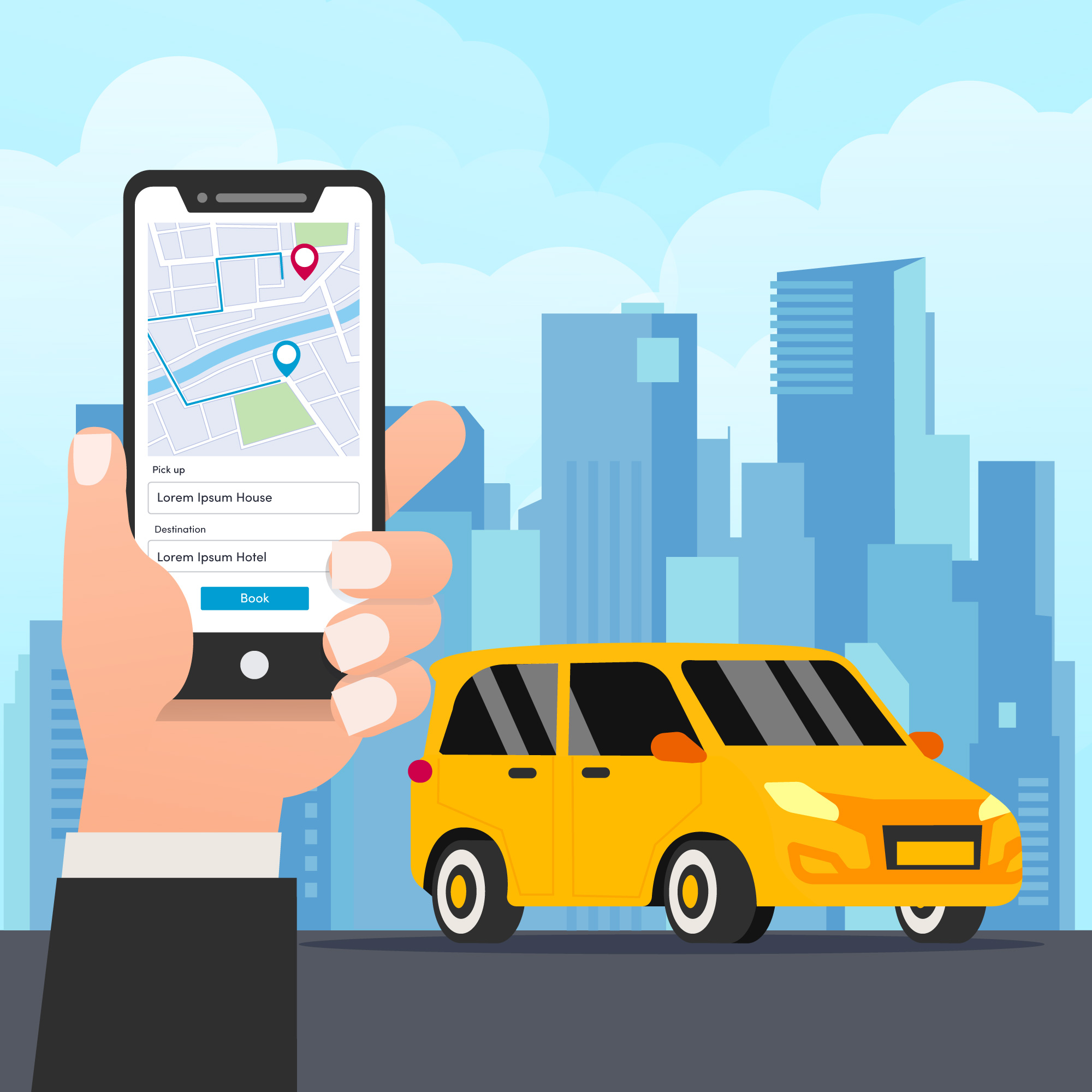Introduction to the Taxi App Market
Evolution of the Taxi Industry
The conventional taxi sector has seen a seismic upheaval in the last decade. There is no need to wave on a street corner or phone a dispatch center anymore. Since the advent of ride-hailing behemoths like Uber, Lyft, and Grab, the landscape has completely shifted. Now a worldwide requirement, it began as a novelty in tech-driven cities. Demand for dependable, effective, and user-friendly transportation services has transformed the once-rudimentary taxi sector into one driven by technology.
This industry is predicted to break historical growth records by 2025. We are seeing a more individualized, effective, and optimized taxi experience as a result of developments in big data, artificial intelligence, and mobile technology. Everything, from quick reservations and cashless payments to real-time driver tracking and safety alerts, is designed with the consumer in mind.
What’s more intriguing is the proliferation of white-label taxi app development solutions. With little effort and money, business owners and seasoned cab drivers may modify these pre-made platforms. It’s a quick way to get into a flourishing market without having to start from scratch. So, when we declare that investing in taxi app development in 2025 is a wise decision, we’re not simply making a bold statement; we’re reflecting a trend supported by statistics and trends in user behavior.
The Impact of Technology on Urban Transportation
Technology has contributed more to urban transportation in the last 10 years than in the previous fifty. Smart mobility is about how, how quickly, how securely, and how efficiently you go from point A to point B. GPS navigation, real-time traffic updates, fare prediction, route optimization, and digital wallets have all become standard features in current taxi applications.
In 2025, we may expect even greater technological convergence—think AI-driven route recommendations, predictive demand mapping, and autonomous vehicle integration. Imagine a taxi service that knows where you’re going before you ever open the app, owing to AI learning your habits and behaviors. This isn’t science fiction anymore.
Investing in such smart tech is the future. Not only does it optimize operations, but it also significantly enhances user satisfaction. Cities are getting smarter, and their transportation systems need to keep up. A taxi app powered by intelligent algorithms becomes not just a service—but a necessity for modern urban living.
Market Trends Shaping 2025
Surge in Urbanization and On-Demand Services
Urbanization is on an unstoppable trajectory. According to recent projections, more than 68% of the world population will live in urban areas by 2050. With dense populations comes the need for efficient, flexible transport options. Traditional public transportation can only go so far. On-demand taxi services bridge the gap between convenience and accessibility.
In 2025, people expect services at their fingertips—and they won’t settle for less. Whether it’s ordering food, booking a salon appointment, or catching a ride, the instant gratification economy dominates. Taxi apps fall perfectly within this framework.
And it’s not just major metropolitans. Tier-2 and Tier-3 cities are also seeing a rise in smartphone penetration and internet accessibility. This opens the floodgates for entrepreneurs to launch taxi apps that cater to untapped or underserved markets. With lower competition in these regions, first movers have a serious edge.
Consumer Expectations in the Digital Age
Let’s be real—consumers in 2025 are not just tech-savvy; they’re tech-demanding. They want apps that are intuitive, fast, secure, and personalized. A laggy interface or lack of payment options is a deal-breaker. Your users want real-time ETAs, driver backgrounds, route options, and cashback offers—all wrapped in a sleek user interface.
This shift in expectations means that merely having an app is not enough. You need an app that performs and stands out. This is where intelligent development strategies, UX/UI design, and post-launch support become critical. Businesses investing in high-quality app development are the ones capturing—and keeping—the market.
Also, let’s not overlook the social responsibility element. Many consumers are choosing greener rides and socially responsible brands. Adding eco-friendly ride options or electric vehicle (EV) fleets into your app can win loyalty and align with modern values.
Benefits of Taxi App Development
Enhanced Customer Experience
At the heart of any successful app is the user experience. A well-designed taxi app ensures seamless navigation, effortless booking, real-time updates, and secure transactions. It’s not just about moving people—it’s about creating a travel experience they enjoy and trust.
In-app chat with drivers, multiple language support, personalized ride suggestions, and loyalty rewards can significantly enhance user satisfaction. A positive experience means more repeat users and higher retention rates.
Plus, features like SOS buttons, driver verification, and trip sharing with friends add layers of security that users genuinely appreciate. Trust is currency in today’s digital world, and nothing builds it like a reliable, user-friendly platform.
Streamlined Business Operations
Taxi apps don’t just benefit riders—they’re a goldmine for operators too. With the help of data analytics, fleet owners can track vehicle locations, monitor driver behavior, optimize routes, and manage bookings in real-time. This operational transparency minimizes inefficiencies and boosts profitability.
Automated billing, tax calculations, driver payouts, and customer service inquiries mean you need fewer staff to handle day-to-day operations. That’s a major cut in overhead costs.
More importantly, having your app eliminates dependency on third-party platforms like Uber or Lyft, allowing you to control pricing, branding, and customer relationships directly. It gives your business autonomy, agility, and room for innovation.
Real-Time Tracking and Safety Features
Safety isn’t just a feature—it’s a priority. In 2025, users expect to know where their ride is, who’s driving it, and how long it’ll take. Real-time tracking is no longer a luxury but a must-have.
Modern taxi apps go further with background-verified drivers, face-recognition login for drivers, trip sharing, emergency alerts, and even route recording. All of these features build confidence, especially among women and vulnerable commuters.
As regulations tighten, these built-in safety features will not just be appreciated—they’ll be required. An investment in a secure taxi app is an investment in brand reputation, compliance, and long-term sustainability.
Key Features Every Taxi App Needs in 2025
AI and Machine Learning Integration
Artificial Intelligence (AI) and Machine Learning (ML) are no longer buzzwords—they’re essentials. In 2025, successful taxi apps will rely heavily on these technologies to provide a smarter, smoother, and more efficient experience. AI helps in predicting user behavior, analyzing traffic patterns, and dynamically adjusting pricing during peak hours. ML algorithms, on the other hand, learn from historical data to improve ride suggestions, driver allocations, and even fraud detection.
Think of AI as your app’s brain. It can recommend the fastest routes, predict rider demand in specific areas, and even flag unusual behavior for security. These features don’t just improve functionality—they impress users with how intelligent and responsive your platform feels. Personalized promotions, tailored route suggestions, and user engagement tactics become way more effective when powered by smart algorithms.
AI also streamlines driver operations. It can suggest optimal break times, locate high-demand zones, and forecast earnings—all of which help improve driver satisfaction. In short, integrating AI into your taxi app in 2025 isn’t optional—it’s strategic.
Multi-Payment Gateways and Wallets
In a world where cash is fading fast, taxi apps must provide seamless and flexible payment solutions. From debit/credit cards and mobile wallets (like Apple Pay, Google Pay, Paytm) to even cryptocurrency options—users expect variety and security. In 2025, adding multi-payment options isn’t just about convenience; it’s about trust.
Riders are far more likely to complete a booking if they see their preferred payment method supported. Offering multiple gateways also boosts your app’s global usability, which is crucial if you’re scaling or planning to serve tourists and international users.
Adding an in-app wallet is a great idea too. It speeds up transactions and can be linked to loyalty programs or cashback offers, encouraging repeat usage. Also, integrating invoice generation and ride history logs provides financial transparency to users and drivers alike. When users trust the transaction process, they’re far more likely to stay loyal to your service.
Driver and Passenger Ratings System
Feedback loops are crucial in service-driven industries, and the taxi sector is no exception. A dual-rating system—where passengers rate drivers and vice versa—helps maintain service quality and accountability. In 2025, transparency and community feedback are valued more than ever.
A well-integrated rating system encourages better behavior on both ends. Drivers strive to maintain high ratings to stay in the system, while passengers also act more responsibly. These ratings help weed out problematic users or drivers and enhance overall platform safety.
What makes modern rating systems more powerful is the layer of analytics behind them. For example, the app can flag frequent low ratings, identify patterns (e.g., a driver being consistently late), and even prompt intervention or retraining. Combine this with written reviews, emoji feedback, and incident reports, and you’ve got a quality control system that works in real time.
By 2025, trust will be a currency in the digital ride-hailing space. Ratings, reviews, and feedback features will be essential to build and maintain that trust, making your app the go-to choice for riders.
Revenue Potential and Monetization Models
Commission-Based Model
This is the tried-and-true method of monetization. You allow drivers to use your platform and charge a commission on every completed ride. Whether it’s a flat rate or a percentage-based system, this model scales beautifully with user growth.
In 2025, the commission model will remain highly lucrative, especially when combined with value-added services. For instance, premium driver support, insurance integration, or vehicle financing can justify a slightly higher commission rate. By offering more than just ride bookings, you build loyalty among your driver community and secure long-term partnerships.
Additionally, you can offer tiered commissions—giving better rates to high-performing drivers. This motivates quality service and retains top talent on your platform. The more rides completed, the more revenue your app generates, making this a sustainable and scalable model.
Subscription Plans for Drivers
Another powerful revenue stream is offering subscription models for drivers. Instead of—or in addition to—commission cuts, you can offer monthly or weekly subscription packages that allow drivers unlimited bookings for a fixed fee.
This model provides predictable income for the app owner and removes the commission burden from drivers. Many prefer this system because it gives them more control over their earnings. You can even offer multiple tiers—basic, standard, and premium—each with different perks like customer support priority, exclusive zones, or marketing boosts.
By 2025, as more drivers look for independence and better earnings, subscription models will become increasingly attractive. It’s a win-win situation when structured correctly: drivers enjoy stable costs, and you enjoy consistent revenue.
Advertising and In-App Promotions
Your taxi app is more than just a ride-hailing tool—it’s a digital platform with prime real estate. Whether it’s banner ads, sponsored rides, or promotional popups, in-app advertising can generate significant revenue. Collaborate with local businesses, cafes, or events to display targeted ads to riders.
Better yet, integrate dynamic ad placements that adjust based on user behavior or location. A user on their way to the airport might see luggage deals; someone headed downtown might see ads for happy hour specials. Contextual advertising in 2025 will be laser-focused and AI-powered.
You can also use your own platform for internal promotions—pushing premium features, offering loyalty points, or upselling new ride categories like luxury or green vehicles. These promotions not only increase revenue but also enhance user engagement and retention.
Challenges and How to Overcome Them
Regulatory Compliance and Legal Hurdles
One of the biggest roadblocks in taxi app development in 2025 is navigating the regulatory landscape. Different regions have different laws—some cities require taxi licenses, and others mandate background checks and insurance coverage for drivers. Failure to comply with local regulations can result in fines, bans, or even app removal from marketplaces.
But here’s the good news: these challenges can be overcome with the right legal counsel and smart tech integration. Build compliance into your app from day one. This includes automating document verification for drivers, integrating local tax rules into payment systems, and clearly outlining terms of service and privacy policies for users.
Partnering with local transportation authorities or adhering to industry bodies’ guidelines can also pave the way for smoother market entry. Showing a proactive approach toward legal and safety standards can even give your app a competitive edge in tightly regulated regions.
High Initial Investment Costs
Developing a fully functional taxi app isn’t cheap. From UI/UX design and backend development to cloud hosting and post-launch marketing, the costs can add up quickly. For many entrepreneurs, this is a major hurdle.
However, consider this—there are several ways to minimize upfront investment without compromising quality. White-label taxi app solutions offer a cost-effective way to launch quickly. You get a robust product with core features already built-in, allowing you to focus on branding and customization.
Additionally, you can start small with a Minimum Viable Product (MVP) that includes only essential features, and then scale as revenue flows in. Many successful startups started this way, using early customer feedback to guide future updates. It’s not about launching big—it’s about launching smart.
Driver Recruitment and Retention
Attracting reliable drivers is just as important as attracting customers. After all, what’s a taxi app without drivers? In a competitive market, drivers will go where the earnings are better and the workload is manageable.
To address this, your app must offer fair compensation, performance-based rewards, flexible scheduling, and prompt payouts. But even more than that, create a community. Offer drivers training, support, and incentives. Add features like performance dashboards, fuel discounts, and referral bonuses.
Happy drivers mean better service and more satisfied customers. And in 2025, word-of-mouth—especially from drivers—is one of the most powerful tools for growing your brand.
How to Get Started with Taxi App Development
Choosing the Right Development Partner
Your development partner can make or break your taxi app. Choose a team that understands not just the tech, but the business. Look for companies with experience in building ride-hailing or logistics apps, a strong portfolio, and good client reviews.
It’s also wise to go for a team that offers end-to-end services—from concept to launch, and post-launch maintenance. The best partners act more like collaborators, helping you identify features you might’ve missed and suggesting improvements for scalability and security.
Don’t just go for the cheapest bid. This is a long-term investment and quality matters.
Planning the Feature Set and UX
A well-thought-out feature set is the heart of a great taxi app. But it’s not about loading the app with every possible tool—it’s about choosing what your audience needs and presenting it in a user-friendly way.
Focus on clean design, intuitive navigation, and quick load times. Your users shouldn’t need a manual to figure things out. Use onboarding tutorials, tooltips, and smart UI elements to guide new users.
At the same time, plan for scalability. What works for 500 users may crash with 5,000 if your backend isn’t prepared. Use cloud infrastructure and microservices architecture so your app can grow with demand.
Marketing Your Taxi App Successfully
You’ve built a great app. Now what? You need to market it aggressively. In 2025, a strong digital presence is non-negotiable. Invest in SEO, local ads, influencer partnerships, and app store optimization (ASO). Create engaging content that educates users about your app’s benefits—blog posts, videos, reels, and case studies.
Also, encourage users to leave reviews and refer friends. Referral programs with cashback or discounts can work wonders. The goal is to create buzz, get downloads, and generate repeat usage.
Don’t forget to monitor analytics. Use tools to track user behavior, bounce rates, drop-off points, and conversion paths. This data is gold—it tells you what’s working and what needs fixing.
Conclusion
Taxi app development in 2025 is more than simply an opportunity; it is a smart step into a rapidly increasing, technologically advanced business with enormous possibilities. With cities becoming denser, people expecting rapid, seamless services, and technology providing limitless innovation, the timing could not be better. Regulation, competition, and development expenses are some of the obstacles, but they can be overcome.
Your taxi app may emerge as the next major force in the ride-hailing market if you approach it with a clear strategy, a strong technological basis, and a user-first mentality. So, whether you’re an entrepreneur eyeing the mobility sector or an established fleet owner wanting to digitize, now is the moment to get involved.
FAQs
1. Is it profitable to build a taxi app in 2025?
Yes! With the rising demand for on-demand transport and tech advancements, taxi apps can generate substantial profits through commissions, ads, and subscriptions.
2. How much does it cost to develop a taxi app in 2025?
The cost varies based on features and location, but expect to invest anywhere from $15,000 to $100,000 for a high-quality, scalable app.
3. What features are essential for a taxi app in 2025?
Real-time tracking, AI-based route optimization, multiple payment options, and safety tools like SOS and trip sharing are must-haves.
4. Can small businesses benefit from launching a taxi app?
Absolutely. Even local operators can grow by offering an app-based service, especially in underserved regions or niche markets.
5. What’s the best way to promote a new taxi app?
Use a mix of SEO, app store optimization, social media marketing, referral programs, and local influencer partnerships to drive visibility and installs.









